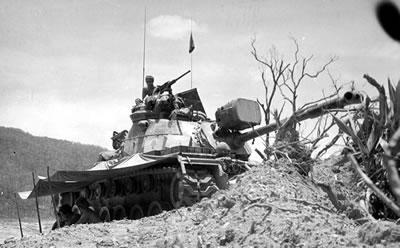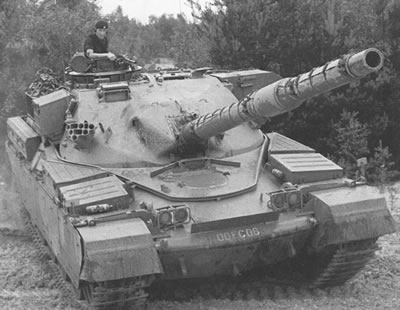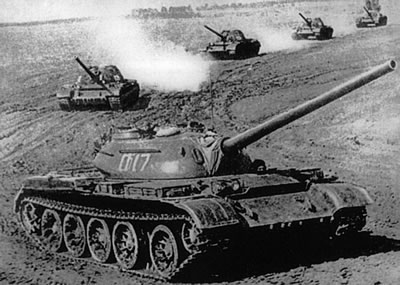After World War II ended, an “Iron Curtain” across Europe divided the continent between Western and Soviet spheres of influence.
Political and ideological differences led to an enormous amount of mistrust between the two sides.
Both sides had large stockpiles of weapons that had been produced during the Second World War.
During the Cold War, there was never a full scale conflict between the USSR and the West. Thus, it was a “cold war”, as opposed to a “hot war”.
However, there was a great deal of spying and political maneuvering.
The North Atlantic Treaty Organization (NATO), which was designed to protect the West from the Soviet Union, was formed in 1952.
 In 1955, the Soviet Union and its allies formed the Warsaw Pact to protect themselves from the West.
In 1955, the Soviet Union and its allies formed the Warsaw Pact to protect themselves from the West.
Germany was divided into West Germany and East Germany, with West Germany becoming part of NATO and East Germany becoming part of the Warsaw Pact.
Western and Soviet tanks of the Cold War tended to differ from each other in their basic appearance – Western tanks had high turrets and Soviet tanks had low silhouettes. Western tanks were suited to hiding behind an obstruction and firing over it. Soviet tanks, however, were harder to hit when in the open, which made it easier for them to survive when making a massed armored charge.
NBC (nuclear, biological, chemical) protection became an integral part of tanks on both sides of the Cold War.
The main battle tank came into existence during the Cold War as both Western and Communist tank designers realized that it was more efficient to build one tank that could be used in many different situations than to build different tanks for different functions – heavy tanks to support infantry and artillery, medium tanks to engage in battle with other tanks, and light tanks to be used for reconnaissance.
While there was never a true war between the West and the Soviet bloc there were proxy conflicts between countries that had formed alliances with either of the two sides.
During the Korean War, Communist South Korea, supported by Chinese and Soviet forces, fought South Korea, which was supported by United Nations forces.
In the Vietnam War, China and the Soviet Union provided the North Vietnamese Army and the Viet Cong with weapons, while the West supplied the South Vietnamese Army with weapons.
During the Arab-Israeli conflicts of the Cold War, the Arab nations received weapons from the Soviet Union while Israel received weapons from the West.
In 1979, Soviet forces invaded Afghanistan to support the Communist government there against Muslim rebels, who were themselves supported by the United States and China.
The Soviets often supplied weapons to groups who claimed to be communist rebels.
Communist China received a large amount of military aid from the Soviet Union at the beginning of the Cold War. The Type 59 main battle tank, Communist China’s first tank, was based on the Soviet T-54 MBT. In the late 1960s, tensions between the USSR and China began to reassert themselves.
Japan’s Type 61 main battle tank, which entered service in 1962, was based on America’s M48 Patton medium tank. The Type 61 main battle tank was Japan’s first post-World War II tank. After World War II, Japan was allowed to use its armed forces only for defense.
NATO Cold War Tanks
The nations of NATO were considered equal within the organization. They sometimes cooperated on joint military projects, but often each nation just designed and used whatever weapons it wanted, so that NATO military equipment ended up being very diverse.
American Cold War Tanks
In 1944, near the end of the World War II, America’s M26 Pershing heavy tank entered service.
The M46 Patton medium tank, which was based on the M26, appeared in 1950.
Both the M26 Pershing and the M46 Patton were the main American tanks of the Korean War. The M46 Patton medium tank was the only tank to see battle in the Korean War, but in no other war. All other Korean War tanks were also used either in World War II or in Vietnam.
The M46 Patton was followed by the M47 Patton medium tank, which appeared in 1952, and afterward, by the M48 Patton medium tank, which entered service in 1953.
The M48 Patton was the primary American tank of the Vietnam War. Various nations around the world still use it today.
An upgraded version of the M48, the M60 main battle tank appeared in 1948.
The M41 Walker Bulldog light tank was an American tank that entered service in 1951. It was designed as a replacement for the M24 Chaffee. The M41 Walker Bulldog was used by the South Vietnamese Army during the Vietnam War, but not by the American army.
The M41 Walker Bulldog light tank is still being used by a number of different armies around the world today.
In 1968, the M551 Sheridan light tank, which was designed to replace the M41 Walker bulldog entered service. The M551 Sheridan light tank was used in Vietnam, during the 1989/1990 invasion of Panama and during the Persian Gulf War of 1990/1991.
The M103 heavy tank, which entered service in 1957, was the United States’ last heavy tank. It never saw combat, and was phased out of service beginning in 1972.

British Cold War Tanks
The A34 Cruiser Comet, which entered service in 1945 and was used at the end of the World War II, remained in service with the British Army until 1960. It was then replaced by the A41 Centurion, which had also entered service in 1945.
Because the British were worried that the Comet and Centurion would not be able to stand up to big Soviet tanks, they built the FV214 Conqueror heavy tank, which entered service in 1956. The Conqueror was unreliable, hard to maintain and hard to maneuver.
It was used only in West Germany and was never engaged in combat. It was removed from service in 1966.
Britain’s FV4201 Chieftain main battle tank entered service in 1967. It is still used by some armies in the Middle East.
French Cold War Tanks
France was occupied by the Germans during World War II, so tank design had to take place in secret during the war.
The Char ARL-44 heavy tank, which entered service in 1946, was an improved version of the Char B1 heavy tank. It was designed as a transitional tank, to be replaced by the AMX-50. Only 60 Char ARL-44 heavy tanks were built.
The AMX-50 heavy tank never got past the prototype stage. The French decided to use M47 Patton medium tanks from America instead.
France’s AMX-13 light tank entered service in 1953. It was designed for transport by air.
The AMX-30 main battle tank started out as a collaborative project between France, Italy and West Germany to design a tank to be used by all of Europe. The project never got past the prototype stage, and France went on to develop its own tank, the AMX-30. The AMX-30 is still used by France and by other countries around the world.
West German Cold War Tanks
When building their tanks, the West Germans focused on mobility rather than protection.
Development of the first West German tank, the Leopard I main battle tank, began as part of the collaborative European project that led to France building the AMX-30 MBT. West Germany, like France, exited the project and went on to develop its own tank. The new West German tank was the Leopard I.
 Warsaw Pact Cold War Tanks
Warsaw Pact Cold War Tanks
The Warsaw Pact was under the control of the Soviet Union, and most of its military equipment was standardized.
After World War II was over, the Soviet Union still had a large number of T-34/85 medium tanks.
An advanced version of the JS-2 heavy tank, the JS-3 also became available.
The T-54/T-55 main battle tank, which entered service in 1950, was supplied to Communist China.
During the Vietnam War, the USSR provided the Viet Cong and the North Vietnamese Army with T-54s and T-55s.
In 1952, the USSR’s PT-76 light amphibious tank entered service. This tank was designed to be used for reconnaissance, to support a beach invasion, and to cross underwater obstacles during an assault.
It was used by the North Vietnamese Army during the Vietnam War, where it was useful for crossing rice paddies and travelling over bridges that could not support the weight of larger tanks.
The T-10 heavy tank, the last of the Soviet heavy tanks, first appeared in 1953. It was phased out of service when the Soviets realized that it was more efficient to focus resources on building and maintaining many main battle tanks instead of a few heavy tanks.
In 1962, the T-62 main battle tank, which was based on the T-54/T-55 entered service. The T-62 was the first tank to have a smoothbore gun.
The T-64, an upgraded version of the T-62, appeared in 1966. It had steel and ceramic composite armor.
In 1973, the Soviet Union’s T-72 main battle tank entered service. Like the T-64, it had composite armor. Inexpensive to mass produce, the T-72 was designed to be exported to other Warsaw Pact countries.
The T-72 main battle tank has been exported to many countries worldwide, and is still in use in Russia and in other countries.
The T-80 main battle tank, which entered service in 1976, was the first Soviet tank with a laser rangefinder and a ballistic computer. Like the T-72, it is also still being used in Russia and elsewhere.